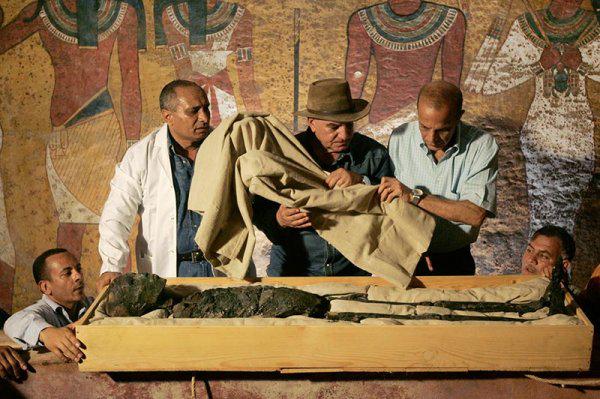 Egyptian researchers remove the three-thousand-year-old mummy from its sarcophagus for CT-scanning in 2005. The mummy was returned to its original resting place inside Tutankhamen’s tomb in 2007. The tomb, known as KV62, has been closed to the public for conservation since 2010. A replica is due to open in 2014. Photograph by Kenneth Garrett, courtesy of National Geographic.
Egyptian researchers remove the three-thousand-year-old mummy from its sarcophagus for CT-scanning in 2005. The mummy was returned to its original resting place inside Tutankhamen’s tomb in 2007. The tomb, known as KV62, has been closed to the public for conservation since 2010. A replica is due to open in 2014. Photograph by Kenneth Garrett, courtesy of National Geographic.
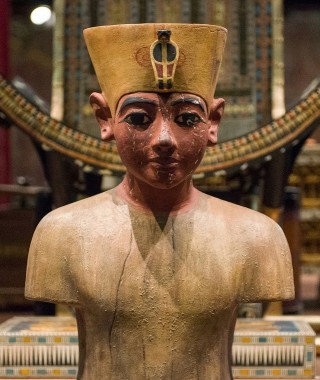 Is the mummy in Tutankhamen’s tomb that of the young pharaoh or was his body substituted by a look-alike during burial? Was the Boy-King brutally murdered and his dismembered body switched to confound his assassins—as if to say ‘Osiris himself hath returned’? According to Dr Laurence Oliver, the body found in tomb KV62 is not that of Tutankhamen but of a close cousin. Moreover, King Tut had been killed and his severed limbs offered to the Nile crocodile.
Is the mummy in Tutankhamen’s tomb that of the young pharaoh or was his body substituted by a look-alike during burial? Was the Boy-King brutally murdered and his dismembered body switched to confound his assassins—as if to say ‘Osiris himself hath returned’? According to Dr Laurence Oliver, the body found in tomb KV62 is not that of Tutankhamen but of a close cousin. Moreover, King Tut had been killed and his severed limbs offered to the Nile crocodile.
A clothe-maker’s mannikin of the young Tutankhamen.
Note how the painted features halt around his neckline.
“Some mysteries ever remain so, even to the end of time.” El Eros
Historical overview
Tutankhamen’s death marked the end of a royal bloodline and a return to the gods of the old kingdom. In the backlash against his father, Akhnaton, the so-called Heretic Pharaoh, almost all public records of Tutankhamen disappeared as the memory of his family was erased by the usurper Horemheb. Within decades the tomb of Tutankhamen had also vanished under the sand where, for over three thousand years, it remained undisturbed. All that changed on 4 November 1922.
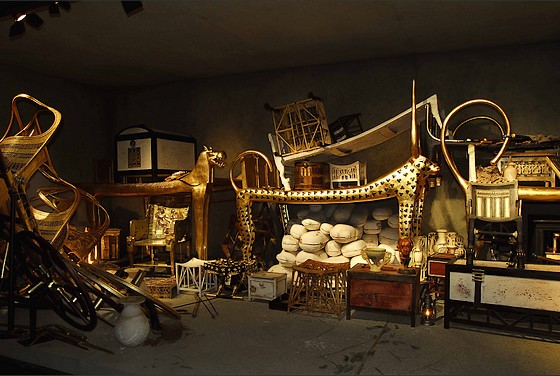 Howard Carter’s discovery of Tutankamen’s tomb in 1922 was an international sensation. It not only proved to be the best preserved and most intact pharaonic tomb in the Valley of the Kings, but sparked renewed interest in ancient Egyptian culture and history. Ever since, each and every disclosure concerning the life and death of Tutankamen has resulted in a worldwide media spectacle.
Howard Carter’s discovery of Tutankamen’s tomb in 1922 was an international sensation. It not only proved to be the best preserved and most intact pharaonic tomb in the Valley of the Kings, but sparked renewed interest in ancient Egyptian culture and history. Ever since, each and every disclosure concerning the life and death of Tutankamen has resulted in a worldwide media spectacle.
Carter’s observation when unwrapping the mummy was more correct than he could ever have realised: the king was indeed being shown as Osiris.
There are no surviving records of Tutankhamen’s death. As a result, his untimely demise became the subject of widespread suspicion and debate, leading to speculation that he was either killed by his vizier Ai, who then succeeded him, or that he died from a blow to the back of his head. While the forensic evidence is scarce and inconclusive, and likely to remain so, we do know with some certainty that Tutankhamen’s tomb was hurriedly prepared; being intended for a private individual and still incomplete. Furthermore, the scale and decoration of his tomb are modest when compared to other burial chambers in the Valley of the Kings. Nevertheless, Tutankhamen’s spectacular funerary treasures bear testimony to his importance and include the gold death mask that now symbolises the magnificence of ancient Egypt.
Prevailing views
Rigorous X-ray and DNA tests were conducted in 1968, 1978 and 2005. Recent results, released in 2010, confirm that Tutankhamen was the son of Akhnaton. While speculation of an assassination remain, the overall consensus is still that of accidental death. According to Egypt’s head archeologist, Zahi Hawass, Tutankhamen died from infection following a thigh bone fracture (National Geographic, September 2010). Damage to the head, he adds, merely occurred during the mummification process.
British scholars, on the other hand, propose that Tutankhamen’s death was caused by a chariot crash, severely crushing his chest and pelvis (BBC 4, 4 November 2013), while Egyptologist Salima Ikrambut claims that the mummy’s “erect penis” symbolized King Tut’s god-like power, “emphasizing the divinity of the king and his identification with Osiris” (The Independent, 3 January 2014). None of this really matters, of course, if the body is not that of Tutankhamen. Today, amid claims of homosexuality, incest, disease and genetic defects, an independent view emerges that could help set the record straight.
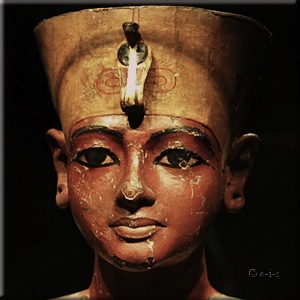
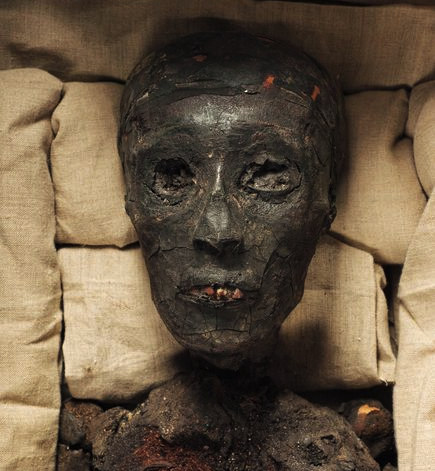 Portrait of the youthful Boy-King (left) as found in his tomb; and the alleged mummy of Tutankhamen (right).
Portrait of the youthful Boy-King (left) as found in his tomb; and the alleged mummy of Tutankhamen (right).
“Unbeknown to official history, I had a son by a beloved mistress Hareth, who was also my court singer. The child was called Tutankhaton, and the child was destined to rule as Tutankhamen.” Akhnaton, KoS p.420
Independent view
Dr Laurence Oliver offers a unique overview of the eighteenth dynasty rulers and their links across history in our previous post, including unprecedented details about Akhnaton and Horemheb. Their karmic biographies were conveyed in 1996 and are cited in Knot of Stone, Chapter 94. What follows here serves as an addendum to that chapter, confirming old suspicions while adding new insights to the mysterious circumstances of Tutankhamen’s death. The cited passage was received clairaudiently in 2002—eight years before Zahi Hawass announced Tutankhamen’s DNA results—and is published here for the first time.
Beloved brother, six years ago I gave you an account of my life as Akhnaton. Now I come to tell you more about Tutankhamen. I need not reiterate what I have already said, except to emphasise that Tutankhamen was the son of Akhnaton. His mother was Hareth, Akhnaton’s beloved mistress.
There are depictions of Akhnaton together with a boy whom he adores. Some Egyptologists take this boy to be Smenkhare and see these images as homoerotic. They conclude that Akhnaton was therefore homosexual. How so? Modern scholars err in these assumptions since Akhnaton was not “the homosexual” pharaoh of ancient Egypt.
The young child depicted with Akhnaton was indeed his own beloved son Tutankhaton, who became his co-regent after the banishment of Nefertiti—before his name was changed to that of Tutankhamen—and not any lover. Smenkhare was, as I have told you, Akhnaton’s younger brother and made his co-regent after Tutankhamen’s abduction by the priests of Thebes. Smenkhare reigned briefly at Akhetaton [today Amarna] after Akhnaton’s death.
Akhnaton’s tomb has never been found, being a secret chamber beneath the ruins of a temple at Thebes. His loyal followers had discreetly entombed his mummy together with the unembalmed body of Hareth in this secret shrine to Aton, to protect it from the wrath of the Amenite priests who would have desecrated it. They never suspected that his final resting-place was in their midst, within their own domain and where they themselves never dreamed to look. This will all yet be discovered in due time, as will the ancient Hall of Records in that vicinity.
The tomb of Tutankhamen, which has stirred up such excitement, never contained the mummy of Tutankhamen. Tutankhamen was murdered and his body dismembered. His remains were secretly conveyed to the Nile to be devoured by the crocodile.
To preserve Tutankhamen’s dignity after his distasteful dismemberment, a suitable substitute had to be found. It was the son of Smenkhare, a few years younger than Tutankhamen, who willingly forfeited his life so that he might be entombed in his cousin’s stead with the dignity befitting a pharaoh. Smenkhare’s son so closely resembled Tutankhamen that they could have been brothers. His name, unrecorded, was Maat-aton.
Smenkhare died before these events, leaving Maat-aton and his family in hiding under the protection of the prominent and resourceful Ai. It was Ai who plotted to defy insult and confound Tutakhamen’s murderers by using an intact body for burial. To this end Maat-aton agreed to give his life, taking the poison prepared for him. So it was, my child, that the surrogate Tutankhamen was interred with all the riches of a royal funeral.
You are wondering why they did not set up Maat-aton as a living surrogate for Tutankhamen, and simply keep mum about the murder? Such a ruse would not have worked. News of the murder had quickly leaked out, and although Maat-aton sufficiently resembled Tutankhamen in age and appearance to have doubled for him at a funeral, he would not have been able to impersonate him in life for long before the plot was exposed. In the event, the conspirators were quite dumbfounded that the dismembered body had been reassembled. This invested Tutankhamen in the eyes of the people with a mystique akin to that of the god Osiris himself.
Egyptologists have little hope of reconstructing the subtle intrigues and intricacies of that ancient time from their scanty evidence. Too many pieces of the jigsaw puzzle are lost, and even with the best will in the world, their exerted efforts will always be inconclusive at best and ludicrous at worst. We comment insofar as it matters, not to embarrass them as they so often ridicule our disclosures, but only that the record might be set straight. Some mysteries ever remain so, even to the end of time. Amen. I am El Eros.
Finally, let us compare the official and independent genealogies of Tutankhamen’s family. First, his royal relations according to Zahi Hawass:
Second, Tutankhamen’s royal relations as postulated by Laurence Oliver:
Smenkhare and Tutankhamen (Akhnaton’s brother and Akhnaton’s son) were married to two sisters, Meritaton and Ankhesenamen, eldest daughters of Akhnaton and Nefertiti. Note that Nefertiti’s marriage and her four younger daughters are not shown here.
Summary
Tutankhamen was murdered and his body dismembered. To preserve the dignity befitting that of a pharaoh, and to confound his assassins, an intact body had to be substituted for the royal burial ceremony. To this end Tutankhamen’s cousin Maat-aton agreed to sacrifice his life and took the poison prepared for him. The two boys closely resembled each other and may have been mistaken for brothers. The mummy is therefore not that of Tutankhamen, nor is the “erect penis” his. This is but one of many recent misconstruals (KoS p.420). Egyptologist Salima Ikrambut does get it right, however, when she says the body was prepared to “emphasize the divinity of the king and his identification with Osiris”. Curiously, Carter’s observation when unwrapping the mummy was more correct than he could ever have realised: the king was indeed being shown as Osiris.
Nicolaas Vergunst



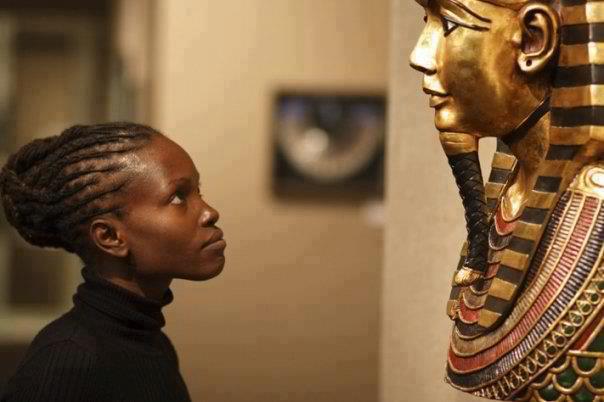


Thanks Nicolaas—what an interesting post! I have never heard about this before.
Truth is stranger than fiction.
I love intrigue, mystery and stories of the past. When I saw the recent Tut exhibit in San Francisco, there was no mention of the switch.
Intriguing—this is really mind-boggling—thank you! I read the incredible story above and am now more perplexed than ever! Will researchers ever get behind the true story? I pray they do!
“Some mysteries ever remain so, even to the end of time.” I hope the record is set straight one day, but the citation suggests that Tutankhamen’s death will remain a riddle. Be that as it may, it doesn’t prevent us from striving to uncover the truth as best we can. Not to do so would be a wasted life or, as Socrates once put it, “an unexamined life is not worth living”. Thanks for your comment, Elsie, it is always good to see you on our page.
Substitution and Doppelgängers are a motif which frequently occurs in myths and legends and are thus archetypical ideas which most likely had their roots in actual occurrences. For example, Moses and Monotheism contains a strong agument that the historical Moses wasn’t one but two persons. Knot of Stone is, itself, a remarkable book.
Thanks for referencing Freud’s study of monotheism, John, his idea that Moses and Akhnaton are one and the same person is indeed intriguing. However, my research shows that Moses, then known as Osiraes, was the Royal Keeper of the Ark of Amen under Akhnaton. (KoS p.419) While Freud’s psychoanalytic theory may generate hypotheses about historical events and their mythical translation, I personally find he says more about himself than he does of Moses and Akhnaton.
From which source, Nicolaas, did you obtain the information about Moses and Akhnaton were the same person? SE XXIII, p 24 ff says: “If Moses was an Egyptian and if he communicated his own religion to the Jews, it must have been Ahkhenaten’s, the Aten religion… My hypothesis that Moses was not a Jew but an Egyptian created a fresh riddle… If however we place Moses at the time of Akhnaton [can we, Nicolaas? You would know] and SUPPOSE [my capitals] him in contact with the Pharaoh, the riddle vanishes. Let us start from the assumption that Moses was an aristicratic and prominent man, perhaps a member of the royal house… he may have played with the idea of one day being the kingdom’s ruler. Being close to the Pharaoh, he was a convinced adherent of the new religion. When the king died and a reaction set in, he saw all his hopes and prospects destroyed.”
Nowhere does Freud say the two were one and the same person, but he does make a well-reasoned case, further on, that in the desert the Jews killed Moses and a second Moses took over. Incidently, National Geographic had an article about Akhnaton’s mummy having been found (identified by DNA), and the whole issue remains fascinating.
My source is Laurence Oliver, a psychiatrist, whose clairaudient messages are cited in KoS. His messages include the karmic biographies of, inter alia, Moses and Akhnaton. According to him, Akhnaton’s tomb is yet to be found, as is his mummy. However, since DNA tests indicate that the skeletonised mummy of KV55 is the son of Amenhotep III and the father of Tutankhamen, Zahi Hawass neatly assumes it is Akhnaton (National Geographic, September 2010). Instead, other Egyptologists suspect it belongs to his younger brother Smenkhare which, astoundingly, Dr Oliver already posited in 2002.
If only the searchers could find written words. They may be found sometime, somewhere…
According to my research, Anita, the ancient Atlantean Hall of Records will soon be found in the vicinity of Thebes. How soon this will be, of course, is hard to say.
Swiss archaeologists discover fifty mummies from Egypt’s Eighteenth Dynasty—including princes, princesses and infants—during excavations of a trashed tomb in the Valley of the Kings. http://www.livescience.com/45186-mummies-unearthed-egypts-valley-of-the-kings.html
Thank you for posting! This post has a lot of value/interest to me, as I am doing research on ancient civilizations; please keep them coming!